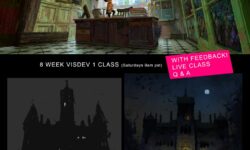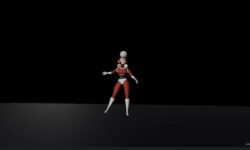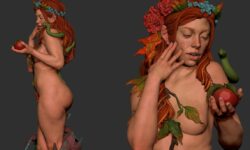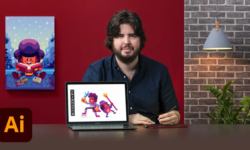V-Ray 5 Masterclass. Your Complete Guide to V-Ray for 3ds Max by Mographplus (VRay 5 and 5.1)
Release date:2021
Author:mographplus
Skill level:Beginner
Language:English
Exercise files:Yes
We’ve been working on this course for the past 4 months and it feels amazing to finally be able to make it available to you.
Every single minute of every single video is planned and thought for, you get the top-notch quality you’ve come to expect from MographPlus.
Now, let’s see what we have in store for you, my focus for this course was to introduce new modern workflows that might not be familiar for most people and at the same time, break older norms that no longer make any sense but people still use them.
For example, how many of you use ACES? Pretty sure not many of you. ACES has improved color management by leaps and bounds and most people don’t know how to properly implement it in their workflows, I promise, you will gain a deep understanding of ACES after watching the course.
Or why are we still using the old way of shader creation which includes a lot of trials and errors by dialing very specific reflection amount, Fresnel amount and so on? wouldn’t a more streamlined, customized PBR workflow be better, more realistic and easier for everyone?
Or for god’s sake, why do we still consider Irradiance Mapping a viable GI solution, the last I checked, it is no longer 10 years ago, there are better ways and you’ll get to learn them throughout the course.
Chapter 1: Introduction (31 min)
We start off the course by introducing V-Ray for 3ds Max, where to find different V-Ray tools and functions, and walk you through the general workflow to get your job down with V-Ray. As we are working with ACES throughout the course, we take a look at how to set up ACES in V-Ray for 3ds Max here before getting back to it in detail in the rendering section of the course.
Chapter 2: Lighting (109 min)
The next section of the course is all about lighting, you learn about the fundamentals of lighting and different lighting techniques while learning about the vast and unique lighting tools that V-Ray offers.
Chapter 3: Global Illumination (69 min)
In section 3, we talk about Global illumination or indirect lighting, first we learn how light rays work in real world and how V-Ray Simulates the same behavior using GI, then we start learning about different GI engines in V-Ray, like Brute force and light cache. We learn how to use these engines in different lighting scenarios to produce the most realistic lighting possible, the pros and cons of each one and where to use them.
And finally learn how to render flicker-free object animations with GI.
Chapter 4: Materials (277 min)
In the next section of the V-Ray 5 Masterclass, we start discussing V-Ray Materials and maps. Not only you learn about all the specific V-Ray Materials, but after watching this section, you will be equipped with the core shading fundamentals and cutting-edge techniques in shader development.
First, we get to know the newly added V-Ray asset browser, an extensive, ready to use V-Ray Material library.
then we learn about the powerful V-Ray Material which is capable of creating all sorts of materials, there are 10 dedicated in-depth lessons covering that material.
Then we discover bump and displacement mapping in V-Ray.
You also learn how to create highly realistic human skin shader using the FastSSS2 material.
V-Ray Hair Next will be covered in detail, it’s an easy to use, yet powerful shader…
After that I will introduce you to a new simplified approach to shader creation, I will show you how to create some of the most daily shaders like plastic, fabrics, wood, concrete, metals and so on.
Then we learn about Blend material, two-sided, light material, ALsurface shader, OSL material and map, scanned material, volume scatter, switch material, curvature and dirt maps, distance map, multisubtex, triplanar, UVW Randomizer and much more.
hopefully after watching this section, you should be very comfortable developing complex shaders in V-Ray.
Chapter 5: Camera (63 min)
Then we learn all about Cameras, camera types, Depth of field, motion blur and everything that relates to working with cameras in V-Ray.
First, we explore V-Ray Physical camera in depth, then we learn how to get Depth of field and motion blur, we learn about different camera types in V-Ray, stereoscopic 3d rendering, lens effects, auto exposure and VR ready renders.
Chapter 6: Rendering (223 min)
Section six of the course is all about rendering with V-Ray, we learn all about the fundamentals of image sampling and ray tracing with V-Ray.
Then we talk about ACES, a system to manage color in all levels of the production, I will give you an overall understanding of what ACES is and does, how to set it up properly in V-Ray for 3ds Max Then I share a few examples comparing ACES and the default color manger and show you why ACES is just way better, and finally how to deal with ACES-managed renders in post.
Then we talk about GPU and hybrid Rendering in depth and how to properly use V-Ray GPU as a production proven render engine.
Then we take a look at V-Ray Frame Buffer settings and how to export still frames and animations out of V-Ray.
The new VFB2 in V-Ray 5 is covered painstakingly, there is a lot to learn, it’s a world on its own that allows you to relight, composite, color correct and compare your renders without the need for an external post processing app…
We also cover Nvidia’s real-time AI denoiser and V-Ray native powerful denoiser in-depth with a lot of comparative examples. We learn how to denoise still frames and animations.
After that, we dive deep into the subject of Render elements. What are the render elements that V-Ray offers and what each one contains and how to save them out correctly to use in post, and finally compositing render elements in fusion will be covered, both the famous back to beauty composite with the beauty render elements and the light mix composite for relighting purposes in post.
Chapter 7: Miscellaneous (77 min)
In the next section, we take a closer look at a few miscellaneous topics, like V-Ray proxy and alembic import, object and light properties, scene exporter and converter, V-Ray Fur, V-Ray Instancer and Clipper.
We also learn about Volume Grid, I show you all the steps you need to render openVDB and other volume formats in V-Ray and how to render amazing and realistic clouds, fire, smoke and explosions using V-Ray.
Chapter 8: What’s new In V-Ray 5.1
In this section, we learn about all the new features that were added to V-Ray 5.1 including the new Translucency section in the V-Ray Material, Multiple Additive Dome Lights, Masks in VFB, VFB Stamp, Intel Open Image Denoiser, advanced Material Override, Camera Lister, Progressive Caustics, New Render elements, Cosmos, GPU improvements and much more.
We also rerecorded a few videos in the Material section of the course to make them compatible with the new translucency section in the V-Ray Material, including the “refraction” lesson, the “translucency” lesson and the “How To Basic Shaders” lesson.





 Channel
Channel






0614 doesn’t seem to work, just so you’re aware
strawberry bro i want 3ds max new modeling course any courses u have
thank you . great work .
upload this if available
Waqas Qazi – Freelance Colorist Masterclass
and
CGMA – Nuke Compositing for 3D Artists
1. yes, but it is huge, I’m lazy to process it )))
2. Nuke Compositing for 3D Artists 2019 – Behnam Shafiebeik
Can anyone open the project files?
me.. )
I download them and try to open, using winrar and it tells me the file is currpt. Can you tell me how you were able to open and extract the files?
Hi, try to use 7zip archiver.
Hi Magnestismus,
I tried it on winRAR and in 7zip and both say its currupt
You succeed to open project file
yep
06 Rendering
0614 error
File has been removed.
These files was unable to play so I just deleted it
0614 File has been removed.
it was broken in the source
ohh ok thanks
project files : cannot open file as archive 🙁
reupload the project files by placing the numbering before .7z format i guess this is corrupting the file
this is the default 7-zip file numbering
Remove the .7z(at the end) from the 1st zip file. Then extract using 7zip
tried but still not succeed
Please reupload “0614_Render_Elements_66”
Thank You for your work sir. Really appreciated
614 is removed is tere any possibility to add it ?
Strawberry do you have Full Time Game Dev course from Thomas Brush? Hope you post it one day 🙁
Hi, could you please add Visual Storytelling for 3D ArchViz by Sonny Holmberg from Domestika? Thanks
0614_Render_Elements_66 has been removed do anyone have a link for that can anyone help me out please
hi sorry, do you think you have the possibility to update the course to 5.2 ?
________!!FOR ANYONE HAVING TROUBLE WITH PROJECT FILES!!________
download all parts>put them in a folder>install 7zip>select all>right click on first file>7zip>extract files here
not worked
The project files ain’t corrupt guys.Leave their names as they are, just remove winrar from your PC & install 7zip,then unpack with it, it will take some time since the contents are 20 GB, but it works fine.
nope not working
Can you please add Chapter 9 (What’s new in VRay 5.2) and Chapter 10 (What’s new in VRay 6)? Thank you very much.